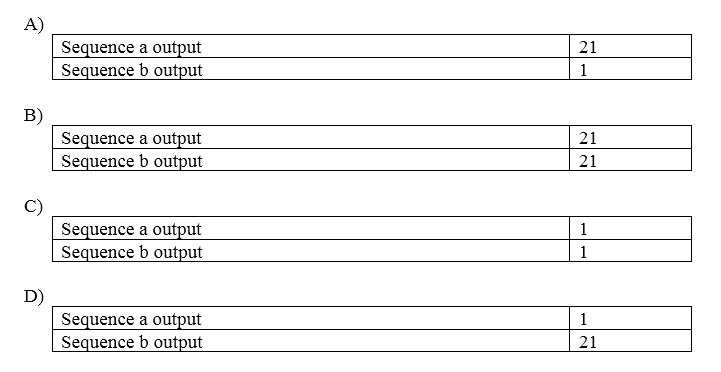You are required to change the Data Guard Configuration protection mode from MAXPERFORMANCE to MAXAVAILABILITY using Enterprise Manager Cloud
Control.
Which two are true about this change?
You are required to change the Data Guard Configuration protection mode from MAXPERFORMANCE to MAXAVAILABILITY using Enterprise Manager Cloud
Control.
Which two are true about this change?
When changing the Data Guard Configuration protection mode from MAXPERFORMANCE to MAXAVAILABILITY, it is true that if the primary database cannot write its redo to at least one synchronized standby database, the protection level will remain unchanged as this prevents the primary database from stalling (Option A). Additionally, the primary database instance will continue to run in such a scenario, ensuring that it maintains availability even if it temporarily cannot write redo to a standby database (Option B). These two aspects ensure that data protection aims are balanced with the need to keep the primary database operational.
Which four database parameters might be affected by or influence the creation of standby databases?
The four database parameters that might be affected by or influence the creation of standby databases are DB_NAME, DB_FILE_NAME_CONVERT, DB_UNIQUE_NAME, and FAL_SERVER. DB_NAME is crucial for keeping the standby database connected to the primary database because it identifies the database. DB_FILE_NAME_CONVERT is necessary to ensure that data file locations on the primary database are correctly translated to the locations on the standby database. DB_UNIQUE_NAME is used to provide a unique identifier for each database, which is essential for role transitions between primary and standby databases. FAL_SERVER specifies the Fetch Archive Log server, which helps the standby database fetch missing archived redo logs from the primary database.
Your Data Guard environment has one physical standby database using Real-Time Query.
Two sentences have been created by these SQL statements:
create sequence a global;
create sequence b session;
Neither sequence has been used since being created.
Session 1 connects to the primary database instance and issues these two SQL statements:
SELECT a.nextval FROM DUAL;
SELECT b.nextval FROM DUAL;
Then session 2 connects to the physical standby database instance and issues the same SQL statements.
What output will be seen for session 2?

When a sequence is created without specifying the CACHE parameter, Oracle databases cache 20 sequence numbers by default. Therefore, when session 1 connects to the primary database instance and issues the SELECT a.nextval FROM DUAL statement, the sequence 'a' will increment from 1. Subsequently, when session 2 runs the same statement on the standby database using Real-Time Query, it will continue from the next cached sequence value in groups of 20. Hence, the sequence 'a' will output 21. For sequence 'b', since it is created with the 'session' option, it maintains a separate range of values per session, and the output remains 1 as it's used for the first time. Consequently, the correct output for session 2 is 21 for sequence 'a' and 1 for sequence 'b'.
You must propose an Oracle Data Guard configuration for a database supporting an OLTP workload that meets these permanent requirements:
1. Data loss is not permitted.
2. Read-only applications should not connect to the primary database instance.
Additionally, there are these requirements, only one of which is ever done at any one time:
3. It should be possible to apply and test designated patches with a minimum amount of downtime.
4. Upgrading to a new database release should be performed with the least possible amount of downtime.
5. New application software releases should be tested against an exact up-to-date replica of the production database.
You propose a primary database with one physical standby database configured in Maximum Protection mode.
Which requirements do you meet?
The configuration of a primary database with one physical standby database in Maximum Protection mode meets the requirement of zero data loss (requirement 1). A physical standby database can be used for read-only applications, keeping them off the primary database (requirement 2). For applying and testing patches with minimal downtime, a physical standby can be switched over to become the primary database temporarily (requirement 3). Database upgrades can be performed on the standby database and then switched over to minimize downtime (requirement 4). Finally, an exact up-to-date replica allows testing new application software releases without impacting the production environment (requirement 5). Therefore, this configuration meets all five requirements.
You must configure an Oracle Data Guard environment consisting of:
1. A primary database
2. Three Physical Standby Databases
You must meet these requirements:
1. A designated physical standby database should become the primary database automatically whenever the primary database falls.
2. The chosen protection mode should provide the highest level of protection possible without violating the other requirement.
Which redo transport mode and protection mode would you configure to meet these requirements?
The chosen configuration should provide high data protection without compromising availability. SYNC AFFIRM transport mode ensures that the primary database waits for acknowledgment from the standby database indicating that redo data has been written to disk. Maximum Availability mode combines this with automatic failover capabilities, ensuring that the standby database can automatically become the primary database in case of failure without risking the availability of the primary database. Therefore, SYNC AFFIRM and Maximum Availability provide the required balance between data protection and system availability.